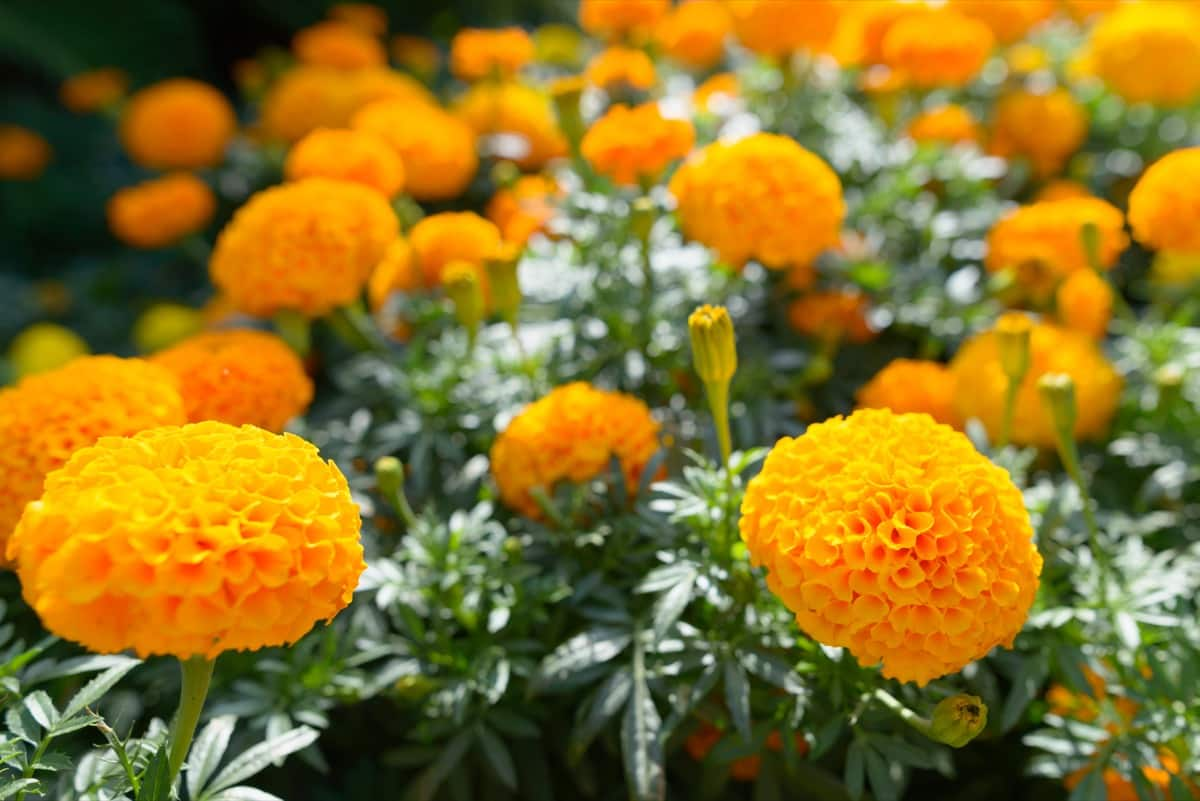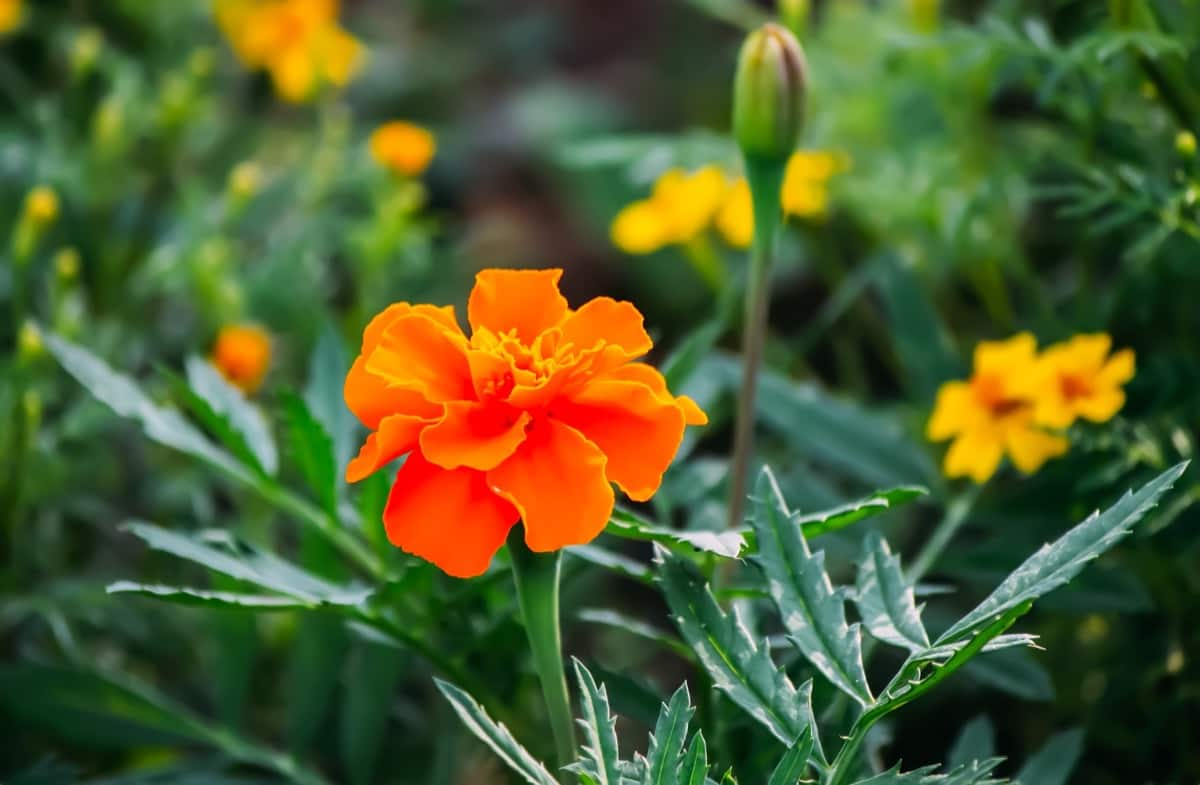Marigold Flowers, popular for their vibrant hues and pleasant scent, bring beauty to gardens across the globe. Their resilience and pest-deterrent properties make them a favorite among many gardeners. However, like all plant life, marigolds may encounter certain difficulties. For instance, gardeners may question, “How to save my dying marigold plant?” when facing issues like marigold leaves curling or buds dying.

Other common problems include breaking marigold stems, diseases needing treatment, or observing black dots on marigold leaves. Understanding their causes and potential solutions can help keep these charming blooms vibrant and healthy in your garden despite these challenges.
10 Common Problems With Marigold Flowers
Why Are My Marigold Flowers Turning Brown?
Marigold flowers turning brown is common and can be distressing to garden enthusiasts. The browning generally signifies a health problem with the plant and is usually due to a lack of water, improper sunlight, or a fungal disease. The most effective solution is to assess the care being provided to the marigold plant. Ensure the plant gets enough water, but not too much, as overwatering can lead to browning.
Aim for a balanced watering routine based on the weather conditions and the soil’s moisture retention capability. Also, check that the plant gets the right amount of sunlight, typically six to eight hours daily. Consider a fungal infection if these conditions persist and the problem persists. Use a natural or chemical fungicide treatment, and remove and discard infected plants to prevent spreading.
How to Prevent Pests From Attacking Marigold Flowers?
While marigolds are famous for deterring many pests, they aren’t entirely immune to them. Aphids, slugs, snails, and whiteflies can attack these beautiful blooms. To prevent pests from attacking marigold flowers, ensure good gardening practices. Regularly remove fallen leaves and debris, avoid overcrowding plants, and ensure proper air circulation to reduce pest attraction.
Additionally, introduce beneficial insects, such as ladybugs and lacewings, to your garden that can help control pests naturally. A gentle insecticidal soap spray can help eliminate pests without damaging the plants for more severe infestations.
What Causes Marigold Flowers to Wilt?
Marigold flowers can wilt for various reasons, including inadequate watering, lack of sunlight, or disease. A common cause can be the presence of a fungus in the soil that causes wilting. This fungus attacks the roots, preventing the plant from taking up water and nutrients, leading to wilting. The treatment includes removing the infected plant and replacing the soil in the area. Water correctly, ensuring the plant cannot sit in water and allow adequate sunlight. Keep a close watch on the plant’s overall health; any changes can signal potential issues before they escalate.
Why Are My Marigold Flowers Not Blooming?
Marigold flowers may not bloom due to insufficient nutrients, particularly nitrogen, inadequate sunlight, or incorrect planting time. To rectify this, the first step is to ensure the marigold plant gets enough sunlight. Marigolds need at least six hours of direct sunlight to bloom properly. Additionally, feeding the plant with a balanced fertilizer can provide the necessary nutrients for blooming. Finally, plant the marigold seeds at the right time. Ideally, sow the seeds after the last frost when the soil has warmed up.
How to Treat Powdery Mildew on Marigold Flowers?
Powdery mildew, manifesting as a white or gray powdery substance on the surface of marigold plants, is a fungal disease that can inhibit growth and lead to premature leaf drop. To treat powdery mildew on marigold flowers, start by pruning and discarding infected leaves and stems to prevent the spread of the disease. Improve plant airflow and prevent watering from above to maintain dry leaves. Use a homemade spray mixture of one part milk to two parts water or a fungicide spray available in the market to combat the disease.
In case you missed it: 7 Causes of Dying Marigolds and How to Fix Them?

What Causes Yellow Leaves on Marigold Plants?
Overwatering, poor drainage, nutrient deficiencies, or disease can cause yellow leaves on marigold plants. Excessive watering or saturated soil can cause root rot, resulting in yellowing leaves. Ensure your marigolds are planted in well-draining soil and are watered adequately but not excessively. In cases of nutrient deficiency, the leaves might turn yellow due to a lack of necessary elements, such as nitrogen or iron. Apply a balanced fertilizer to remedy this issue. If the problem continues, consider diseases or pests. A proper diagnosis is required before treating the plant.
How to Revive a Dying Marigold Plant?
A dying marigold plant can be a gardener’s worst nightmare. The most important steps to save a dying marigold plant are diagnosing the problem correctly and taking swift action. If the marigold leaves are curling or the marigold buds are dying, it may be a sign of stress due to overwatering, under-watering, insufficient light, or disease. Adjust the watering schedule as needed and ensure the plant receives enough sunlight. Prune and treat the plant’s affected areas with the necessary solutions, like fungicides or pesticides.
Why Are My Marigold Flowers Not Attracting Pollinators?
Marigolds are often planted in gardens to attract pollinators like bees and butterflies. If your marigold flowers are not attracting pollinators, it might be due to a lack of nectar, the absence of companion plants, or the use of pesticides. Ensure your marigold flowers are healthy and producing enough nectar. Diversify your flower selection to attract more pollinators. Also, avoid using harmful pesticides, which can repel or kill beneficial insects.
How to Prevent Fungal Diseases in Marigold Flowers?
Marigold diseases and treatment often revolve around fungal infections, with black dots on marigold leaves being a common symptom. To prevent fungal diseases, maintain good air circulation around your plants by avoiding overcrowding. Water the marigold plants at the base instead of overhead to keep the foliage dry. Remove and dispose of any infected plants immediately to prevent the spread of the disease. Consider using a fungicide as a preventative measure during the wet season or if the problem persists.
What Causes Stunted Growth in Marigold Plants?
Stunted growth in marigold plants can be caused by various issues, from improper watering and inadequate light to nutrient deficiency and disease. Overwatering or underwatering can lead to stress in the plant, causing stunted growth. Correct this by ensuring a proper watering schedule based on your plant’s needs and environmental conditions.
Similarly, insufficient light can prevent the plant from performing photosynthesis efficiently, leading to poor growth. Adjust the plant’s location if necessary so it gets at least six hours of sunlight daily. Lack of nutrients, especially nitrogen, can also stunt growth. The application of a balanced fertilizer can correct this issue. Lastly, check for diseases or pests. If marigold stems are breaking or marigold buds are turning black, it might signal a disease or pest issue, requiring the appropriate treatment.
In case you missed it: How to Start Marigolds in Pots: Best Practices for Growing From Seeds and Transplants

Conclusion
While marigolds are generally easy to grow, they can experience various issues. Proper understanding and quick action can often correct these problems, leading to a thriving, blooming garden full of these beautiful flowers. A healthy marigold plant not only adds color and fragrance to a garden but also aids in creating a balanced ecosystem by attracting pollinators and deterring harmful pests.
- Feed Your Flock for Less: Top 10 Tips to Save on Chicken Feed
- Ultimate Guide to Ossabaw Island Hog: Breeding, Raising, Diet, and Care
- Hatching Answers: The Top 10 Reasons Your Chickens Aren’t Laying Eggs
- Eggs and Economics: Breaking Down the Cost of Raising Backyard Chickens
- Defend Your Greens: Proven Methods to Keep Iguanas Out of Your Garden
- Ultimate Guide to Cinnamon Queen Chicken: A Comprehensive Guide for Beginners
- Ultimate Guide to California Tan Chicken: Breeding, Raising, Diet, Egg-Production and Care
- Ultimate Guide to Marsh Daisy Chicken: Breeding, Raising, Diet, and Care
- 10 Types of Chicken Farming Businesses You Can Start for Profits